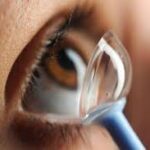Introduction:
High myopia is very common and one of the major causes of social blindness, especially in East Asian
countries. It is characterized by axial length elongation, and induces various specific
complications, including cataract formation, retinal detachment from peripheral retinal tears, myopic foveoschisis, macular hole with or without retinal detachment, peripapillary deformation, dome-
shaped macula, choroidal/scleral thinning, myopic choroidal neovascularization, and glaucoma. It affects your distance vision, you can see objects that are near, but you have trouble in viewing objects that are farther away like grocery store aisle markers or road signs. Myopia treatments
include glasses, contact lenses or surgery.
Types of myopia:
There are mainly three types of myopia. They are mild, moderate, and high:
Mild myopia: Also called low myopia, this iswhen the power of myopia is up to -3.00D.
Moderate myopia: This is when the power of myopia is between -3.00D and -6.00D.
High myopia: This is when the power of myopia is usually over -6.00D.
Complication due to high myopia :
High myopia-related complications include lens pathologies, atrophic and tractional maculopathy,
choroidal neovascularization, peripheral retinal degenerations and retinal detachment, and glaucoma which increases the susceptibility to intraocular pressure (IOP) elevation.
Several kinds of complications may occur due to high myopia. Some are:
Glaucoma: The risk of developing glaucoma was nearly 50% higher (or one and a half times as high) in individuals with moderate to high myopia, compared to those with low myopia.
Cataract: Higher rates of cataract surgery are seen in individuals with high myopia.
Retinal detachment: The risk of developing a retinal detachment is five or six times greater in
people with high myopia compared to those with low myopia. Myopic eyes have a degenerate
vitreous that is more likely to collapse and separate from the retina, also increasing the risk of
retinal tears. High myopia can also cause central retinal degenerative changes such as posterior
staphyloma, lacquer cracks and chorioretinal atrophy.
Myopic macular degeneration (maculopathy): The risk of macular degeneration due to myopia rises
sharply with age and increasing myopia. Myopic maculopathy may take the form of atrophic
changes or be complicated by choroidal neovascular membrane (CNV) formation. Advanced myopic maculopathy causes loss of central vision and there is currently no treatment for the
atrophic form. With the increasing prevalence of myopia, visual impairment caused by this conditions will continue to rise.
Myopia Choroidal Neovascularisation (CNV): Myopic CNV occurs when abnormal new blood vessels
grow beneath the retina. This new blood vessels can leak or bleed very easily, causing a sudden loss
of vision. This condition is potentially blinding if not treated. Multiple eye injections may be required in the treatment of this condition.
Myopic Tractional Maculopathy: As the length of the eye increases, the inner layers of the retina
attempts to pull away from the outer retina causing the retina to thicken. This condition
requires regular monitoring as it may lead to complications in the future. It may also require surgery.
Macular Hole: The macula is an area which is crucial for clear vision. When a hole occurs at the
macula, vision is usually affected. Common complains include blurred and distorted vision. Surgery may be required.
Management:
It is important to make patients aware of these potentially sight-threatening conditions. Any sightloss should therefore prompt patients to seek a complete ophthalmic assessment.
Retinal detachment can affect any age group. Patients should advise to contact an eye specialist immediately if they see flashing lights (usually seen in dim light in the temporal peripheral field)
or floaters, or if they experience visual field loss. They must undergo an urgent dilated exam to exclude retinal tears and/or detachment.
Central visual loss as a result of advanced myopic macular degeneration can affect people of working
age, so examine the macula at every visit. Individuals who develop CNV may be treated with intravitreal anti-VEGF therapies.
The risk of open-angle glaucoma increases in individuals with high myopia, it is wise to assess intraocular pressure and optic disc appearance at every visit and assess visual fields if possible.
Eye care specialists should acknowledge high myopia as a significant cause of visual impairment
and a risk factor for a number of sight-threatening conditions.








